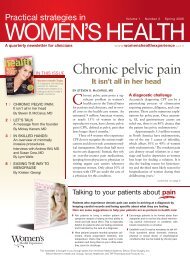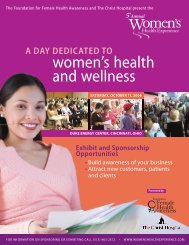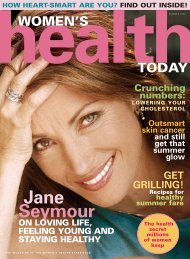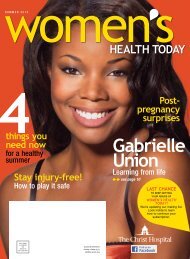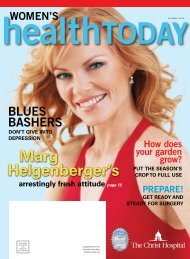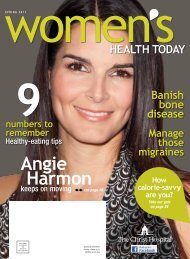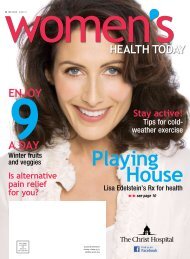Maria Menounos - Women's Health Experience
Maria Menounos - Women's Health Experience
Maria Menounos - Women's Health Experience
- No tags were found...
Create successful ePaper yourself
Turn your PDF publications into a flip-book with our unique Google optimized e-Paper software.
in this issue...s u m m e r 2 0 1 1>> Features23Do youhave diabetes?3 Keep the bloodpumping!4 We’ve come a longway, ladiesMaking pelvic floor issues athing of the past5 Wanna play?8 The gender gap4 health conditions that hitwomen hard10 Dodging diabetes<strong>Maria</strong> <strong>Menounos</strong>masters clean eating18 Kids + TVWhat’s OK and what’s not20 A summer eye-openerTop ways to protect your eyesfrom the sun22 Choose the rightpainkiller23 Do you have diabetes?>> Departments2 LETTER FROM THE FOUNDEREyes wide open6 HEALTH HEADLINESWhat’s making news inwomen’s health6<strong>Health</strong>Headlines© istockphoto.com/Valua Vitaly; © 2011 Thinkstock9 SEX & GENDER MATTERSRx for women14 HEALTHY BITESSpice it up!Add flavor, not salt, to yourcooking16 HEALTHY MOVESEnjoy exerciseLearning to love movement24 HEALTH SMARTSProtect against Lyme!18Kids + TV14Spice it up!www.womenshealthexperience.com1
We’ve comea long way, ladiesMaking pelvic floor issues a thing of the past>> Urinary incontinence, pelvic organ prolapse,chronic constipation—these are issues most of usare uncomfortable talking about. But the reality is,nearly 25 percent of all women will develop these andother pelvic floor disorders—especially women who havedelivered children vaginally or are postmenopausal.The pelvic floor describes the muscles, ligaments,connective tissues and nerves that act like a hammock tosupport the organs of the pelvis—including the uterus,vagina, bladder and rectum. The pelvic floor preventsthese organs from falling down or out, and also plays animportant role in helping these organs function properly.What is a pelvic floor disorder?When damage to the pelvic floor occurs (such as duringchildbirth or due to obesity,chronic coughing, recurrent heavylifting or advancing age, amongother issues), the pelvic floormuscles can become weak or theligaments and tissues can bestretched or torn, leading to apelvic floor disorder. The fivemain categories of pelvic floordisorders include:• bladder dysfunction,including bladderincontinence or difficultyemptyingyour bladder• boweldysfunction, including fecal incontinence or difficultyemptying your bowels• pelvic organ prolapse (when the organs of the pelvis fallout of place), which is often indicated by a pulling, achingor “bulging” sensation in the lower abdomen or pelvis• pelvic pain, including in or around the vagina, bladder,rectum or lower abdomen• female sexual dysfunctionFor generations, many women have learned to livewith pelvic floor disorders, believing they’re a normalpart of aging. It’s important for women to know thattheir pelvic floor disorder symptoms and the underlyingcause can often be corrected.A team approach to treatmentThe Christ Hospital Center for Pelvic FloorDisorders—one of the few centers of its kind in thenation—offers a unique, multidisciplinary approach.Our physicians work side by side, complementing eachother in their areas of expertise, including urogynecology,urology and colon and rectal surgery. Their supportteam—nurses, physical therapists and a physicianassistant—specializes in treating pelvic floor disorders.The team can offer a variety of noninvasive treatmentoptions, such as behavior modification, nutritionalcounseling, physical therapy and medication,to help alleviate your symptoms. If these or othernoninvasive options don’t work, our skilled physicianscan often correct the problem through minimally invasivesurgery, which offers less pain, less scarring and ashorter recovery time than traditional surgery. WHT Do you have a pelvic floor disorder?Take our quick and easy online questionnaire at www.TheChristHospital.com/PelvicFloor. To speak with one of our specialistsabout your symptoms or to learn more about the services offered atThe Christ Hospital Center for Pelvic Floor Disorders, call 513-585-4800.4 women’s health today
Wanna play?© istockphoto.com/Peter Booth>> Think about what it was liketo be a kid. What was your ideaof fun? Jumping rope? Playinghopscotch? Climbing trees? Maybeyou loved hide-and-seek, racingbikes with the neighborhood kidsor playing tag. Looking back, it’splain to see that all those activitieswere just that—activities. Theyburned calories and got your heartpumping, your muscles stretchingand your lungs expanding.If only you could recapture thatplayful feeling, exercise might seemlike fun instead of drudgery. Guesswhat? You can! Try these tips forputting the fun back into fitness:> Join the competition. Try softball,volleyball, tennis or other competitivesports. Find partners atthe same fitness level as you so thegames won’t be too vigorous. Evenbowling or shuffleboard will helpyou get in shape.> Invite yourself to a dance party.Line dancing, square dancing, bellydancing, jazz, tap, ballet—there’sno end to the movements you cando to music. Join a dance club intown, take lessons at the communityrecreation center or just turn up thevolume at home and shake it up.> Take a ride. Find a bike trailthat suits you and pedal away.Remember the freedom that bikeriding gave you when you were alittle girl.> Let it bloom. Turn to the garden,where you can exercise yourbody—and your creativity.> Get a hobby. Find an interest, likebird watching, architecture or rockcollecting, that will add spark toyour city or country strolls.> Play! Your children or grandchildrencan be a great excuse for hoppingon a swing or a seesaw. Teachthem the jingles you used to singwhen jumping rope.> Go sightseeing. Take walkingtours through neighboring townsand cities.> Play mind games. Distract yourselffrom the treadmill or stationarybike by coming up with yourtop 10 list of movies or songs,formulate your to-do list or tacklea pressing problem. WHTGet moving!Looking to get active? TheChrist Hospital Senior CarePreferred Plus (SCPP) programcan help. For just $20 a year($37 for a couple), membersages 50 and older have accessto free health seminars andscreenings, walking clubsand other fitness programs,discounts on athletic shoesand exciting local and nationaltravel opportunities. SCPPmembership is a great wayto meet new people and getsome excitement back in yourlife! Call 513-585-4001 tolearn more.www.womenshealthexperience.com5
<strong>Health</strong> Headlines>> what’s making news in women’s healthUp to date on vaccines?Act fast tohead off astrokeSpeed is key when it comesto stroke. Rapid medical carecan help reduce the risk of longtermbrain damage. Doctorstreat stroke patients with a clotbustingdrug that can help protectthe brain against permanentdamage in the most commontype of stroke, but the drug mustbe given within three hours ofthe stroke’s onset. If someoneyou love is experiencing strokesymptoms, call 911 immediately.(Note when the symptomsstarted so you can tell the physicians.)To help you remember strokesigns and determine whether someoneyou know has had a stroke, think F.A.S.T.:FACE: Does the face look uneven? Can the personsmile?ARMS: Can the person raise both arms and keepthem there?SPEECH: Is the person’s speech slurred or strange?TIME: Call 911 immediately if you notice any ofthese signs.Of course, the best way to avoid a stroke is to takepreventive steps: Quit smoking; maintain a healthy weight;eat a healthful diet that includes plenty of fruits andveggies; and get moving to improve your weight, bloodpressure and cholesterol.Parents: Arm yourself with the latestinformation. The Advisory Committee onImmunization Practices’ (ACIP’s) annual immunizationschedule for children and teens frombirth to age 18 includes new recommendationsfor licensed vaccines in effect as of Dec. 21,2010. The new schedule includes updates for:• the human papillomavirus vaccine• proper use of vaccines for tetanus,diphtheria and pertussis among childrenages 7 to 10 who haven’t completed theirvaccinations• immunization recommendations for childrenwho didn’t receive a dose of Hepatitis Bvaccine at birth• whether to administer one or two dosesof seasonal influenza vaccine based ona child’s history with the 2009 H1N1vaccination• the new 13-valent pneumococcal conjugatevaccine, which will eventually replacePCV7, the current vaccine to preventpneumococcal disease• the recommendation that more high-riskindividuals be given meningococcalconjugate vaccine and a recommendationabout administering a booster dose ofthe vaccineIf you have any questions aboutimmunizations, ask yourchild’s healthcare provider.Images on pages 6 and 7 © istockphoto.com/Reinhold Tscherwitschke/Geotrac/Chihhang; Image on page 7 © 2011 Thinkstock6 women’s health today
Working moms andtheir children’s healthWhile some studies have shown children’s health may improvewhen their mothers work, a new study says the opposite may betrue. Published in the Journal of <strong>Health</strong> Economics by a NorthCarolina State University researcher, the study finds that childrenof working moms are twice as likely to be hospitalized overnight,have an asthma episode or suffer an injury or poisoning as childrenwhose mothers don’t work. The researcher based the conclusionson more than 20 years’ worth of data—gathered between1984 and 2004 and including about 89,000 children—from theCenters for Disease Control and Prevention’s National <strong>Health</strong>Interview Survey. Past studies have concluded mom’s work isgood for kids’ health due to increasedincome, access to health insuranceand improved maternal self-esteem.But this new study challenges thoseconclusions, possiblybecause it accountsfor factors that maynot have been previouslyconsidered. Forexample, it adjusted forthe fact that mothersof very sick childrenmight not be able towork. The author notes,however, that this issueis just one factor toconsider when momsweigh the costs andbenefits of working.Even a heart attackdoesn’t derail fastfood loversSome patients who suffer heartattacks wisely give up their fastfood habits in the six months afterhospitalization. But a recent studypublished in The American Journal ofCardiology found that others continueto hit the drive-through. Researcherssurveyed 2,481 patients who hadsurvived a potentially deadly heartattack. Study authors asked patientsabout their eating habits at the timeof their heart attack and six monthslater to see how the heart eventinfluenced their diets. At baseline,36 percent of participants reportedthat they ate fast food one or moretimes a week. Six months after experiencinga heart attack, 20 percentstill continued to indulge that frequently.Patients who were younger,male, still working and less educatedwere more likely than others to eatfast food at least weekly six monthslater. Based on these findings,healthcare providers may need to gobeyond dietary counseling to helpthese patients stay on track.Some patients who suffer heart attackswisely give up their fast food habits inthe six months after hospitalization.www.womenshealthexperience.com7
Sex & Gender Matters>> By Jennifer Wider, MDThe latest findings on women-specific healthfrom the Society for Women’s <strong>Health</strong> ResearchRx for women© istockphoto.com/Berekin>> Most people have taken a prescription medicationat one time or another. But according toa report from the federal Agency for <strong>Health</strong>careResearch and Quality (AHRQ), not only do womentake more medications during their lifetimes, womenare more likely to suffer from adverse drug eventsthan men.An adverse drug reaction is a harmful, unintendedreaction to a drug taken at a normal dose. Most adversereactions are caused by side effects, drug interactionsand drug toxicity. Fewer reactions are caused by unpredictableeffects that may be immune related, includingallergic reactions and serum sickness (a reaction similarto an allergy).Be awareBecause women are more likely than men toexperience adverse drug reactions, it becomes evenmore important for women to take an active role intheir healthcare. Medication is supposed to make youfeel better, but if it isn’t taken correctly, it can havethe opposite effect. The American Academy of FamilyPhysicians (AAFP) advises you to be aware of thesedetails for each medicine you take:• name (generic name and brand name)• reason for taking it• how much to take and how often to take it• possible side effects and what to do if you have them• how long to continue taking it• special instructions (taking it at bedtime, with meals, etc.)Ask questionsIt’s important for women to inform their physiciansand pharmacists about all medications or supplementsthey’re taking, any known allergies and if they’re pregnantor planning on conceiving in the near future.To be sure you’re taking your medication safely andcorrectly, the AAFP encourages you to ask your physicianthese questions about the medications prescribed to you:• What does the medicine do?• When and how should I take it?• What side effects could I have?• Will the medicine react to any other medicines,foods or drinks?• Should I avoid any activities while I’m taking it?• What should I do if I forget to take it?• How will I know it’s working?Don’t stop at opening the bottle: Research yourmedications. Instead of tossing instructional packageinserts into the garbage, always read them. Takingan active role in healthcare can help lower the risk ofproblems associated with prescription and over-thecountermedications and supplements. WHTLearn more!The Society for Women’s <strong>Health</strong> Research (SWHR), anational nonprofit organization based in Washington, D.C.,is widely recognized as the thought leader in research onsex differences and is dedicated to improving women’shealth through advocacy, education and research. To findthis article and more, visit www.swhr.org.>> Jennifer Wider, MD, is a medical advisor for the Society for Women’s <strong>Health</strong> Research in Washington, D.C.www.womenshealthexperience.com9
DodgingDodgingDodgingDodgingDodgingDodgingDIABETESM a r i a M e n o u n o s m a s t e r s c l e a n e a t i n gB y B o n n i e S i e g l e r>> <strong>Maria</strong> <strong>Menounos</strong> always looks red-carpet ready, with her gleamingsmile, fashion sense and enviable figure. Whether interviewing the hottestcelebs for “Access Hollywood” or “The Today Show,” the former MissMassachusetts Teen USA exudes a sense of style.That wasn’t always the case for the 33-year-old journalist, actress and nowauthor of The EveryGirl’s Guide to Life. During her college years at Boston’sEmerson College, the 5-foot-8-inch beauty packed on 40 pounds, which shehas since successfully lost and kept off. But her weight loss wasn’t predicated onvanity and Hollywood’s pressure to be thin. “My father, who has diabetes, wasa definite motivation for me to lose the weight,” <strong>Menounos</strong> says of her father’stype 1 diabetes, diagnosed more than 30 years ago.continued on page 12 >>10 women’s health today
© 2011 Alex Freund/Contour by Getty Imageswww.womenshealthexperience.com11
continued from page 10Even though she showed no signs of diabetes,<strong>Menounos</strong> was aware that being overweight could contributeto the illness. “I knew I had an increased chanceof getting diabetes,” she adds. “I wasn’t really uncomfortablewith my weight, but at the same time, I waseating tremendous amounts of unhealthy food.”A new way of eatingSo <strong>Menounos</strong> did some research—as she often doeswith her regular work assignments—and found that eatingchili peppers, hot sauce, jalapenos, vinegar and grapefruitcan jump-start weight loss. “They may burn calories,” shesays, “and the flavor they give foods makes me not wantbreads and carbs as much as before. I also drink waterwith lemon, which tastes so good anyway. It’s refreshingand better than grabbing a soda when I’m thirsty.” But<strong>Menounos</strong> didn’t become her own food police. “I stillhave an Oreo cookie or ice cream but only one cookieand I eat sugar-free ice cream.”Today, 10 years later, <strong>Menounos</strong> is a happy andhealthy size 4 or 6. “I’ve kept the weight off becauseI’ve relearned how to eat. Now I eat everything inmoderation. My life doesn’t revolve around food,” shesays. More recently, <strong>Menounos</strong> consulted with YogiCameron, a well-known health and fitness guru whohas worked with everyone from Ellen DeGeneres toMadonna. “He told me everything I was eating washot—very high energy, very high activity. He taughtme how to change my diet a little bit. Ultimately Ilearned how to eat really clean—foods from the groundthat are cooling foods. I’ve cut out gluten and dairy,but occasionally I’ll have some of that. It’s the 99 percentthat I’m proud of in my diet.”Cameron also advises <strong>Menounos</strong> on her eating habits.“I’ll first eat an apple, then around 2 p.m., I’ll have carrotsand hummus or gluten-free bread with some turkey,avocado and tomato. Just very simple,” she notes. In hernew book, <strong>Menounos</strong> devotes a chapter to her love ofcooking, especially Greek dishes. “I’m attracted to balancein foods. I love cooking healthy dishes and that’s what Igrew up with. My mom and I got creative with some newrecipes that we added to the book. I love this veggie pattyshe makes [see recipe below].”The “Live Well, Be Happy” section of the book brings asmile to her face just thinking of it. “Life makes me happy,”says <strong>Menounos</strong>. “I’m a happy person; I always say Greeksare happy people. My dogs make me happy; my family andfriends make me happy; my work makes me happy.”Staying healthyExercise, when time permits, includes yoga, occasionalKrav Maga or some strength training. “I don’t want exerciseto consume my whole day,” comments <strong>Menounos</strong>.“Often, I don’t have time for it, so I’ve learned to substitutetaking the dogs for walks or hikes or taking the stairsup and down. I’ve started running in the last year, rarelymissing a morning run. I was training for the marathonin Greece so I kind of got into it. Now I’m just trying tokeep up with it for endurance reasons, but it’s a good wayto maintain my weight and stay healthy.”Now at her fighting weight and 23-inch waistline,<strong>Menounos</strong> says, “I’m proud of the health accomplishmentsI’ve made in my life. But I still have my ‘fat’jeans in the closet as constant reminders.” WHT<strong>Maria</strong>’s delicious veggie patty> 1 can white navy beans (15 oz.)> ¾ cup breadcrumbs> ½ cup chopped onion> 2 tsp. crushed garlic> ¼ cup parsley> 2 Tbsp. olive oil> Crush beans with a fork or food processor and mixin the rest of the ingredients; blend well together.Shape into patties and grill.© istockphoto.com/Lauri Patterson12 women’s health today
PRESENTED BYTMYour Update inWomen’s <strong>Health</strong>Join Dr. Karram and his guests from The Christ Hospital for an in-depthradio program exploring a variety of topics essential to your health.Check out upcoming topics and recent programs,available now at www.womenshealthexperience.com.Hosted byMickey Karram, MDPresident and Co-founder,Foundation for Female<strong>Health</strong> Awareness;Director of Urogynecology,The Christ Hospital,CincinnatiAlternate Sundays8:30–9 a.m.on 101.9 FMAdvance directives andliving willsPreparation for end-of-life care>> Guest: Rev. Duane Campbell,Critical Care Chaplain, The Christ HospitalPastoral DepartmentAllergies! Nothing to sneeze at!Cope with and control your allergies>> Guest: Albert Weisbrot, MD, FamilyMedicine Physician, Mason FamilyMedicine, The Christ HospitalAvoiding and preventingsports injuriesA plan for all athletes>> Guest: Marc C. Schneider, MD,Orthopaedic Surgeon, The Christ HospitalOrthopaedic AssociatesBoost your child’s healthQuick and easy foolproofprescriptions for parents>> Guest: Ron Reynolds, MD, FamilyMedicine Physician, Anderson FamilyPractice, The Christ Hospital MedicalAssociatesHeart valve disordersHeart-to-heart understanding ofvalvular heart disease>> Guest: Ian Sarembock, MD,Interventional Cardiologist, The ChristHospitalOrgan donationLife, pass it on>> Guest: Michael A. Cardi, MD,Nephrologist, Medical Director ofTransplantation, The Christ HospitalTwo-hour meeting,one-hour bladder!Get help at The Center for PelvicFloor Disorders>> Narrator: Mickey Karram, MD,Advanced Urogynecologic and PelvicSurgeon; Medical Director, Center forPelvic Floor Disorders, The Christ Hospital>> Guest: Janice Rafferty, MD, Colonand Rectal Surgeon; Medical Director,Center for Pelvic Floor Disorders, TheChrist HospitalSPONSORED BYIN CONJUNCTION WITHwww.womenshealthexperience.com13
HEALTHY BITESSpice it up!Add flavor, not salt, to your cooking>> How do you infuse your meals with more flavorwithout picking up a salt shaker? Just add herbs andspices! This summer, pick garden-fresh herbs in yourbackyard or visit a farmers market for the freshest taste.4 smart waysto cut saltMost Americans should have lessthan a teaspoon of salt daily. If youhave high blood pressure, you mayneed even less. Flavorful herbs andspices can help reduce your relianceon salt. Try these other tricks:Buy low- or no-salt versions of1 your favorite foods.2Eat fewer frozen dinners andcanned soups.3Buy fresh, not processed, meatand poultry.4Rinse beans under running waterto reduce the sodium level.14 women’s health today
Flavorful herbs andspices can helpreduce yourreliance on salt.Images on pages 14 and 15 © istockphoto.com/Michał Ludwiczak/Jaunmonino/Daniel BendjyMediterranean-style fishwith tomatoesFor fish> 4 3-oz. portions red snapper or bass fillets> 1 Tbsp. olive oil> ½ tsp. salt> ¼ tsp. ground black pepperFor tomato sauce> 1 Tbsp. olive oil> 1 red bell pepper, cut into ¼-inch sticks> 1 green bell pepper, cut into ¼-inch sticks> 1 cup canned no-salt-added diced tomatoes> 2 cups canned no-salt-added tomato sauce> 1 Tbsp. fresh oregano, chopped (or 1 tsp. dried)> 1 Tbsp. fresh basil, chopped (or 1 tsp. dried)> 1 Tbsp. fresh parsley, chopped (or 1 tsp. dried)> Preheat oven to 350 F. Rinse and dry fillets.Coat with oil. Season with salt and pepper. Bakefor 25 to 30 minutes, until fish flakes easily witha fork at its thickest part. For sauce, heat oilin saucepan. Add peppers and cook for 3 to 5minutes, until firm but tender. Add tomatoes andtomato sauce. Bring to a boil, then reduce heatand simmer for 10 to 15 minutes or until tomatoesare soft. Add oregano, basil and parsley, thensimmer for an additional 2 to 3 minutes. Serveeach fish fillet with 1 cup of sauce. Serves 4.Per serving: 213 calories, 8 g fat (1 g saturated fat), 30 mgcholesterol, 365 mg sodium, 15 g carbohydrates,4 g fiber, 20 g proteinCold fusilli pasta withsummer vegetables> 8 oz. whole-wheat fusilli> 2 cups cherry tomatoes, rinsed and halved> 1 large green bell pepper, sliced> ½ cup red onion, thinly sliced> 1 medium zucchini, shredded finely> 1 15½-oz. can low-sodium chickpeas(garbanzo beans), drained and rinsed> 1 Tbsp. fresh basil, cut into thin strips(or 1 tsp. dried)> ¼ tsp. salt> ¹/8 tsp. ground black pepper> 1 Tbsp. extra-virgin olive oil> 2 Tbsp. balsamic vinegar> ½ cup Parmesan cheese, shredded> Cook pasta according to package directions,then rinse to cool. Place vegetables and beans ina large serving bowl. Season with basil, salt andpepper. Add pasta. Combine oil and vinegar, thenpour over contents of bowl. Mix until well coated.Divide into four equal portions. Top each with2 Tbsp. shredded Parmesan. Serves 4.Per serving: 418 calories, 11 g fat (3 g saturated fat), 10 mgcholesterol, 455 mg sodium, 63 g carbohydrates, 13 g fiber,21 g proteinRecipes courtesy of the National Heart, Lung, and Blood Institute.www.womenshealthexperience.com15
HEALTHY MovesEnjoy exerciseLearning to love movement>> You finally find the time to exercise.You get started and you feel pretty proudof yourself—until you realize 15 minutesinto your activity that your jeans are cuttingoff all circulation to your lower extremities.The bottom line: If you’re uncomfortableduring your workout, your commitment tofitness will be short-lived. Before startingan exercise program, get your healthcareprovider’s OK and then try these tips tomake exercise enjoyable.16 women’s health today
Pick a pleasant, convenient place. If youenjoy nature, find a walking path, plan aweekly hike or just jog around the neighborhood.But if battling the elementsseems like a hassle, find activities you cando at home. Stock up on exercise DVDs,invest in a piece of exercise equipment or keep apair of dumbbells on hand.> Find the right time. Research shows people who exercisefirst thing in the morning are more successful atmaking fitness a habit. But that doesn’t mean othertimes aren’t conducive to working out. In fact, scientistswho study circadian rhythms (the body’s internal clock)say the best time to exercise is within three hours ofyour body’s peak temperature (it fluctuates plus or minus1.5 F each day). That’s when muscles are more flexible,reaction time is quicker and resting heart rate and bloodpressure are lower.> Dress right. Light, loose layers are your best bet forexercising in comfort. You’ll be able to move freely andcan remove a layer if you begin to perspire.Also, make sure you wear appropriatefootwear.> Get energized. Drink 8 ounces of waterbefore you exercise and at 20-minute intervalsduring exercise. If you plan to work outfor more than an hour, a low-fat energy bar canprovide the fuel your body needs to keep moving.> Listen … to music or an audio book or chat with afitness buddy to make your routine more fun. Moreimportant, listen to your body: If you feel pain or realdiscomfort, stop your activity.> Eliminate distractions. If you exercise at home, askyour family not to interrupt you. Use the bathroombefore your activity (if urinary incontinence is a problem,specially designed pads can help, or read more on page 4).> Vary your activities. Boredom is one of the biggestcommitment killers, so find several activities you enjoyand pick and choose depending on the weather andyour mood. WHT© istockphoto.com/Adam SmigielskiFitting in fitnessExperts recommend exercising for at least 30 minutes a day. But that can be overwhelmingwhen your day is already jam-packed. If you can’t spare the full 30 minutes in one shot,why not break up your routine into three 10-minute bites? Try these suggestions:• Walk the dog. He needs togo, and you both need theexercise. If you’re feelingambitious, try a light jog fora few minutes and see ifFido can keep up.• Speed up your shopping.At the mall, take a briskwalk around the perimeterbefore popping into yourfavorite stores.• Scour your home. Burnmajor calories while youclean: Pick up the pacewhile you vacuum, give thebathtub a vigorous scrubbingand stop multitasking:The more trips you maketo the basement, the moreexercise you’ll get.• Take a video game break.Interactive games keepyou moving with workoutroutines, simulated tennis,bowling and much more.• Eat and run. Maybe youcan’t take a full hour forlunch, but surely you cansqueeze in a 10-minutewalk after your sandwich.• Watch a video. Manyfitness DVDs offer 10-minute workouts. Do justthree segments a day!• Get off the couch. Don’tjust sit there duringcommercial breaks. Getup and dance, run inplace—anything that getsyou moving.• Take the stairs, often.Use your staircase at homeor find a stairwell in youroffice building and headonward and upward.www.womenshealthexperience.com17
Kids + TVWhat’s OK and what’s not>> Doesn’t it seem like every child in America knowswho Elmo, SpongeBob and Dora are? Many childrentoday watch more TV than is recommended for their agegroups, according to research, which may give them theopportunity to become well-acquainted with these characters.Although television viewing can be useful andeducational in certain circumstances, too much TV canprove detrimental to your child’s health and development.The American Academy of Pediatrics recommendsthat children younger than age 2 watch no television andthat all children older than age 2 watch no more thantwo hours a day. But studies have found that up to twothirdsof infants and toddlers watch about two hours ofTV daily, and older kids watch almost four hours a day.Too much TV time means that kids interact less withtheir parents, siblings or caregivers and have fewer opportunitiesto converse or learn. Children also typically sitidle while staring at the screen, so they’re missing out oncountless hours of potential physical activity, which maycontribute to the obesity epidemic. What can you do?Flip off the TVaround infantsand toddlers. Studieshave found that childrenyounger than age 2 whowatch TV are spoken toless than their TV-freecounterparts, whichmay slow their cognitivedevelopment anddelay their ability tospeak. And the shortsegments plus quickscene changes in manyprograms may make itdifficult for youngstersto concentrate, possiblycontributing to a risein attention deficithyperactivity disorder(ADHD).Read to youryoungsters. Forsome children, TV timereplaces reading time.Whenever possible,choose books over TV;too much TV time maydelay your child’s abilityto learn to read.Watch with yourkids. You canhelp your kids develophealthy attitudes aboutwhat they see on TV ifyou’re there to commenton it. Explain that commercialsare designed tomake people want thingsthat they don’t necessarilyneed. Focus on lessonslearned in educationalprograms such as certainletters or numbers.Help older kidsmap out whatto watch. Set hourlylimits on daily TV viewingtime, and promoteeducational programsover fluff. Teach kids thatit’s better to watch theirfavorite shows than surfthe channels.18 women’s health today
Too much TV canprove detrimental toyour child’s healthand development.© istockphoto.com/Jose Manuel Gelpi Diaz; © 2011 ThinkstockLimit all screentime. Some kidsplay video games or usethe computer for twohours a day, in additionto four hours of TVviewing. Experts recommendthat the two-hourlimit on TV viewingshould include videogame and computertime, too. Keep TVs andcomputers out of kids’bedrooms to ensure thatthey’re following therules.Ban eating infront of the TV.Excess TV watchingamong children hasbeen associated withobesity for a numberof reasons: Kids sitpassively while theywatch, instead of gettingexercise, and they’rebombarded with commercialsfor sugarybreakfast cereals andjunk-food snacks. Ifthey eat while watchingsomething engrossing,they may not noticewhen their bodiessignal that they’refeeling full. Parentsshould lead byexample to makeit easier for kidsto stop snacking oreating meals in frontof the TV.Opt forcommercialfreeviewing. One studyfound that the amountof idle time in front ofthe TV wasn’t linkedto obesity; it was timewatching programs withcommercials. Childrenages 6 and younger whowatched commercial-freeTV shows or videos wereless likely to becomeobese than their junkfood-commercial-viewingcounterparts.Spend moretime outdoors.Run around the backyardor head to the park whenyour kids would normallyhunker down in front ofthe TV for an hour of cartoons.The fresh air andphysical activity will begood for both of you. WHTCalm your concernsIf you have concerns about your child’s activitylevel, talk with his or her doctor. If you’re lookingfor a new family medicine physician, visit www.TheChristHospital.com or call The ChristHospital physician referral line at 513-585-1000.www.womenshealthexperience.com19
A summereye-openerTop ways to protect your eyes from the sunFortunately,protecting your eyesfrom the sun doesn’thave to be difficultor unsightly.© istockphoto.com/Yulia Popkova/Claudelle Girard20 women’s health today
Choose the right painkiller>> The pharmacy’s pain-relief aisle is chock-fullof different over-the-counter (OTC) drugs thatpromise to ease your aches and pains, but notevery painkiller is right for you. Most should helpwhen you have a toothache or a pounding headache,but what if you have a sprained ankle or a fever? Readon to learn more, but if you’re pregnant or have a seriousmedical condition, talk with your physician beforetaking any medication.Doubling upYou have a splitting headache and a horriblecold, so you swallow acetaminophen, then takesome over-the-counter cold medication. Youmay have just unwittingly taken twice therecommended dose of acetaminophen, sincemany cold medications contain painkillers. Readlabels carefully to avoid this problem becausetoo much acetaminophen can cause liverdamage, and too much aspirin or ibuprofen cancause stomach bleeding. Accidentally combiningpainkillers (taking ibuprofen, then a cold remedywith acetaminophen) is also dangerous.Stay safe with meds!Talk with your physician about your pain and anyover-the-counter medicine you may be taking.If you’re in need of a doctor, call our physicianreferral line at 513-585-1000 or visitwww.TheChristHospital.com.Painkiller When to use When to avoid> Aspirin It’s a nonsteroidal anti-inflammatorydrug (NSAID), which means it canhelp relieve swelling and inflammationassociated with injuries or overuse.Aspirin helps headaches, too. Somemigraine-relief medications combineaspirin, acetaminophen and caffeine.> Ibuprofen Like aspirin, ibuprofen is an NSAID, but it’sstronger and longer lasting than aspirin.> Acetaminophen Acetaminophen isn’t an NSAID, so it’sbest suited as a fever reducer and forpain relief not associated with swellingand inflammation.> Naproxen This NSAID is also a longer-lasting alternativeto aspirin but, like ibuprofen, itcan cause stomach irritation.Don’t give aspirin to children or teens; theymay develop Reye’s syndrome, a health conditionthat affects all organs of the body. Peoplewith asthma or chronic nasal congestion mayhave an aspirin allergy; ask your doctor beforeusing. Generally, pregnant women shouldn’ttake aspirin as it may harm the fetus.NSAIDs may cause stomach irritation andbleeding when taken too frequently.Check with your physician before taking thisor any other OTC painkiller if you consumethree or more alcoholic beverages daily.Don’t give naproxen to a child without aphysician’s OK. WHT© 2011 Thinkstock; Image on page 23 © istockphoto.com/Valua Vitaly22 women’s health today
HEALTH SMARTSProtect against Lyme!>> Lyme disease is spread when an infecteddeer tick attaches itself to your skin. Thebacteria that cause the disease enter through thisbite and make their way to your bloodstream.Want to know more about this seriouscondition? Test your knowledge withthe following true/false questions.TRUE or False?1 Lyme disease always causes a redbull’s-eye rash.2 Lyme disease is treatable.3 To remove a tick, use a hot matchor nail polish to force it to let go.4 You can help prevent Lyme disease.5 Lyme disease is contagious.AnswersFalse. For some infected people, the rash may be1solid, or it may take the form of multiple red spotson the body. Others will have no rash at all. They may onlyexperience other Lyme symptoms, such as fever, chills,headache, fatigue and joint and muscle aches. For late-stageLyme that’s spread, you may have arthritis (especially in onejoint, such as the knee) or nervous system problems, such asmuscle weakness and concentration problems.True. Physicians use antibiotics, which are very2successful in treating early-stage Lyme. An antibioticregimen can last anywhere from 14 to 30 days. Late-stageLyme may be treated with intravenous antibiotics and medicationsto reduce pain and swelling.Test your healthknowledge onlineTake more health quizzes and assessments onlineat www.womenshealthexperience.com.Plus, find out what other women are saying byparticipating in our online polls!False. These folk remedies might actually cause3the insect to dig in deeper. Instead, use tweezers tograsp the tick firmly by the head—as close to the skin aspossible—and pull steadily on the tick till it lets go. Thenswab the bite site with rubbing alcohol. You may want tosave the insect in a tightly closed container, in case yourphysician wants to take a look at it.True. There’s no foolproof way to stop tick bites,4but you can lessen the chance they will occur byavoiding wooded areas and shady grasslands; wearing longpants, sleeves and socks, as well as light-colored clothingto spot ticks (which may be no bigger than the head ofa pin) more easily; spraying your clothing and skin withinsect repellent containing 20 percent to 30 percent DEET(this chemical should not be used on the hands of youngchildren or on infants younger than 2 months old) or oil oflemon eucalyptus (do not use on children younger than age3); checking for ticks on you, your family and pets onceinside; showering and washing clothes after being outside;and keeping your yard clear of tick-friendly refuges, such asbrush and leaves.False. Lyme cannot be passed from person to5person. However, you can get the disease more thanonce, so practice prevention!© 2011 Thinkstock24 women’s health today
PRESENTED BYStay informedStay connectedTMStay healthy with www.womenshealthexperience.comWomen’s <strong>Health</strong><strong>Experience</strong>offers healthnews andinformation justfor women!> Sign up for a free monthly e-newsletter that deliversthe latest health news, trends and tips to your inbox.> Test your health smarts on fitness, nutrition,disease prevention and more with online quizzes.> Take our online health assessments to determineyour risk for common diseases and conditions.> Learn what other women are thinking byparticipating in our online health polls.> Find out what Women’s <strong>Health</strong> <strong>Experience</strong> can do for you!It’s all here—and it’s all for you at www.womenshealthexperience.com.SPONSORED BYIN CONJUNCTION WITH





